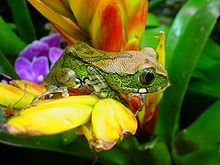
Back Boompaddas Afrikaans Granota arborícola Catalan Tree frog English Arborano Esperanto Rana de árbol Spanish قورباغه درختی Persian Grenouille arboricole French Frog crainn Irish Ծառի գորտ Armenian Katak pohon ID



Tree frogs are frogs that spend most of their life in trees.
There are several lines of Neobatrachia which have evolved into tree frogs. These groups are only distantly related, but they have evolved for a long time in similar conditions. The result is that now there are species from different groups which look very much like each other. This is convergent evolution. It goes so far that in almost all cases, where one group occurs, another does not. Their current distribution shows that the last common ancestor of the groups lived before the dinosaurs disappeared.
The frogs do not normally come down to the ground, except to mate and spawn. Some build foam nests on leaves and rarely leave the trees as adults. In some species the eggs develop directly into adults; in others the tadpole stage is spent in the water pool of a large tropical tree leaf.
Many tree frogs can change their colour for better camouflage. Others are poisonous (poison dart frog), and display warning colouration.
Tree frogs are usually tiny, as their weight has to be carried by the branches and twigs of their habitat. While some reach 10 cm (4 in) or more, they are typically smaller and more slender than terrestrial frogs.
Typical for "tree frogs" are well-developed discs on the finger and toe tips. The fingers and toes and the limbs tend to be rather long. This gives better grasping ability. The genus Chiromantis is most extreme in this respect: it can oppose two fingers to the other two, resulting in a vice-like grip.
- ↑ "Rare frog dies, one of only two left in the world". WKYT News. 2012-02-17. Archived from the original on 2013-10-04. Retrieved 2012-02-17.